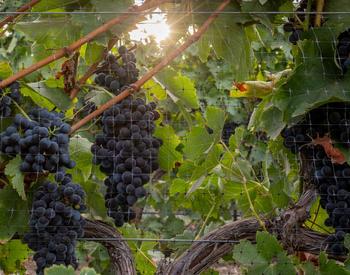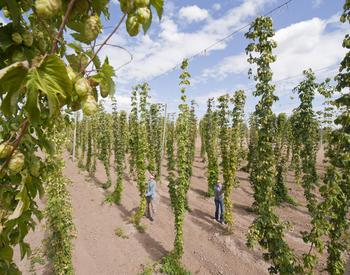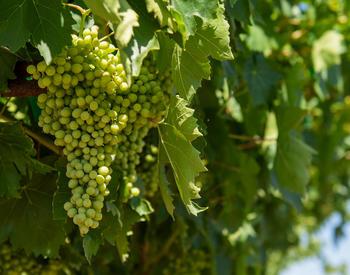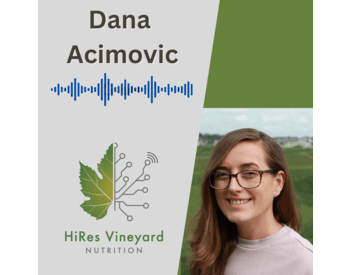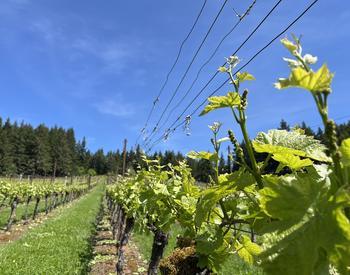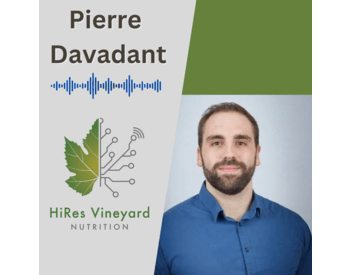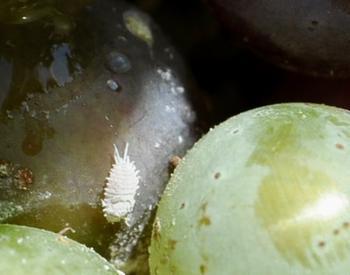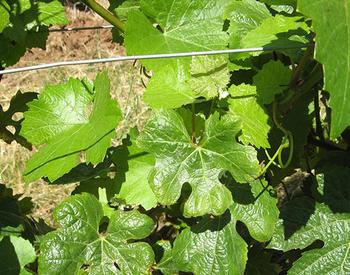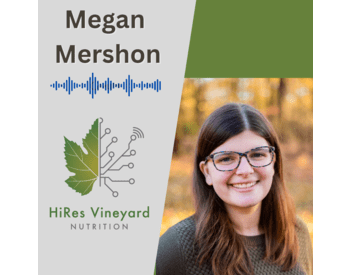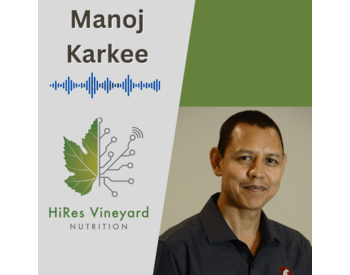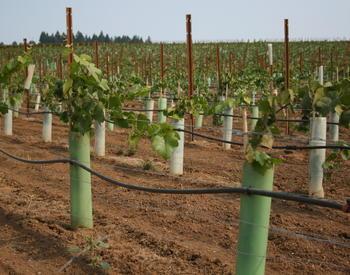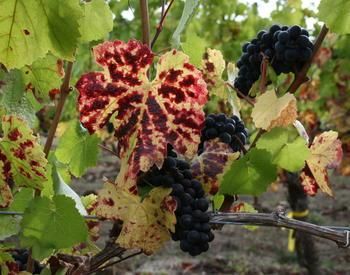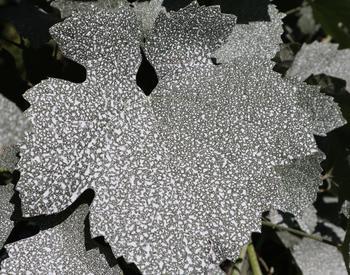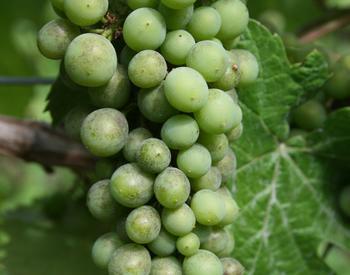Transcript
(00:00:00) Patty Skinkis
This is the High-Res Vineyard Nutrition Podcast, devoted to helping the grape and wine industry understand more about how to monitor and manage vineyard health through grapevine nutrition research. I am your host, Dr. Patty Skinkis, Professor and Viticulture Extension Specialist at Oregon State University.
(00:00:22) Patty Skinkis
Most growers, researchers, and scientists are interested in making informed decisions with easy to use tools that give actionable data. We know that there aren’t any “easy buttons” in farming or even in agricultural research for use in any system let alone vineyard systems. However, research is underway to determine the best tools and methods to integrate sensors to acquire, manage, and interpret data that is useful to growers for decision-making. In an earlier episode, I spoke with Dr. Jan van Aardt, a co-PI (Principle Investigator) on the HiRes vineyard nutrition project who is working with hyperspectral imaging and how it is used in agriculture and how the technology is being used specifically in vineyard projects in the eastern United States. Joining us today, to get the West Coast perspective is Dr. Alireza Pourreza, a project co-PI working in the engineering team of the HiRes Vineyard Nutrition Project and who is using similar methodologies, but is applying them here in the western United States on namely California.
Dr. Ali Pourreza is an assistant professor at the University of California Cooperative Extension Service. He works in the department of Biological and Agricultural Engineering and is based in Davis California. He also serves as the director of the Digital Agriculture Lab at UC Davis where many projects are underway to develop decision support tools for specialty crop growers, including grape growers. Dr. Pourreza is an accomplished scientist who works to apply his work for agricultural producers across many crops. He has been featured in many trade magazines as people keep an eye on his cutting-edge technology as it nears practical application. He earned his bachelor's in agricultural machinery from Ferdowsi University and went on to complete two master's degrees, one in mechanics of agricultural machinery at Ferdowsi University, and another in agricultural and biological engineering at the University of Florida. Finally, he wrapped up his education with a PhD in agricultural and biological engineering at the University of Florida, and we're pleased to have him with us today to talk about his engineering work in the HiRes Vineyard Nutrition Project.
(00:02:42) Patty Skinkis
Thank you for joining us today Ali.
(00:02:43) Alireza Pourreza
Thank you for having me Patty.
(00:02:46) Patty Skinkis
One of the most interesting things about your work I think is that you are really applying it to on farm trials and practical studies. Just looking through your work on social media and online with a Digital Agriculture Lab, I see that you've got a lot of neat research that's already being shared with the world and of course growers in California. Can you tell us about some of the main objectives of the work at the Digital Ag Lab?
(00:03:11) Alireza Pourreza
Of course, so our main goal in the Digital Ag Lab is to optimize food production by developing mechanized or automated approaches that improves yield while reducing waste inputs, and of course environmental footprints. Sensing and actuations are the two essential aspects of our research program. We know that a proper farm management relies on accurate data and timely data that is interpreted by validated models and can provide growers with some variable insight that will help them to make the best decision. Currently, there are advanced remote sensing technologies available at low cost to growers, and they can use it to map their own vineyards or field. However, the problem is there is a lack of validated, and crop specific data interpretation models. That limits the value of this high-resolution imagery that could be available to growers in a specialty crop. So, in our commitment to advance this research goal, our top priorities are developing these interpretation models, and we are focusing on several major crops in California, such as almond, grape, pistachio, and walnut. So, in the extension part of our program, we are trying to educate the farmers and the public about these technologies that are available to them. How is the best practice, and what information they need to know before they employ these in their cultural or farming practice, and we extend scientific knowledge to various type of methods. For example, we do a lot of extension talks, videos, workshops, and social media as you mentioned. Also, we do a lot of publications that can be used by growers or anyone who is interested in this knowledge.
(00:05:33) Patty Skinkis
So specifically, can you tell us about some of the projects that your program and the UC Digital Agriculture Lab have been involved with for the HiRes vineyard nutrition project?
reza Pourreza
Of course. We want to develop some decision support tools using these available spectral, or other type of data, that we can collect from the fields. The reason that we want to do that is because currently, most specialty crops are managed in a uniform way. This is why we know there is a spatial and also temporal viability in yield that needs to be at list by variable rate technology, and a variable rate technology requires a sensing technology that can monitor in a large scale and in high precision, so growers can have this timely information about their plants status and they can include that information in their decision making. For example, the HiRes Nutrition Project, we are trying to optimize nitrogen management. The reason for that is, if we do not provide enough nitrogen to a plant, that would have a negative impact on the photosynthesis assimilation. It reduces the quality and quantity of yield and it can limit the root growth and also development. If we don't provide enough nitrogen, that would increase the carbon to nitrogen ratio, that also reduces photosynthesis and leads to early leaf synthesis. But, at the other end, if we provide more nitrogen, more than the plant needs and demands, we can talk about other issues. Specifically, two different aspects of these issues are the impact on the plant which will lead to overproduction of leaves. And consequently, the vines will be prone to diseases and pests. It can increase stress but decrease yield and decrease quality. Some people may think otherwise, that providing more may lead to more yield. Well it's not...it's not true. It can also have some impacts on the environment. We know over fertilization would harm the water resources because it will be leached to the irrigation system, and it can contaminate the natural water resources. Different forms of problems like eutrophication or acidification of freshwaters and coastal areas would be the outcome of this. And for example, for freshwater, it would be very expensive to purify [contaminated water]. So, if we can have a system to manage nitrogen, we can avoid all of these problems and also have a better yield and quality.
(00:08:56) Patty Skinkis
So, with the focus on nitrogen. How exactly are you doing this? I know that you use drones a lot and that spectral imagery is being used, but can you tell us about, before we get into the fine details of how it's done, can you tell us more about what types of grapes you're evaluating and where your project sites are?
(00:09:20) Alireza Pourreza
So, our project site is focused in the Central Valley of California, close to Fresno, and we have a few experimental plots at Kearney Research and Ag station in Parlier, where I work with Dr. Matthew Fidelibus. We also run some semi-controlled environmental condition for some potted vines. We work mostly on table grapes and raisin, but we also do some work with wine grapes with some companies to test the outcome of our research at the same time in a real situation. So, as you mentioned, yeah, we use mostly drones. but we also use satellite imagery and different types of images we collect from vineyard to have an estimation of canopy profile details. For example, vine height, the canopy light interception, and the volume, and also, we evaluate the spectral characteristic of canopy. Now, not only in the visible but also in the infrared regions of the electromagnetic spectrum. So, we know that over the past few years it has become much easier to capture earlier photographs using small drones. They can carry different types of cameras and sensors, different rates. We don't have a lot of problems collecting our data. The difficulty is the handling and processing and interpretation of these huge amount of data that ideally should be done in a near real-time. So, it requires a high capacity of computational resources and also cloud computing, and these are all the technologies of future. So, by doing this research, we are preparing the solutions for near future when other technologies will be also available to fuse into this and lead to a near real time and semi-automated nitrogen management.
(00:11:47) Patty Skinkis
The timing aspect I recognize is a big problem managing and interpreting that data. Right now, what is the fastest you can turn around a response, assuming that you know how to interpret the data. In other words, what is the fastest you can go from image acquisition to final decision?
(00:12:09) Alireza Pourreza
That's a really good question, and it highly depends on what kind of analysis you want to do. You can do some really quick analysis right after you collect the imagery with the drone in the field and look at some vegetation indices, maybe within an hour. Or you can conduct a very robust calibration and processing and analytics that requires a lot more time, and just the computational time of doing all these processing pipeline would probably take about a couple of days. But right now, this pipeline is not automated and it requires some operators to handle the data processing. So right now, without any systematic approach, we can say maybe a week we will need to process the data and extract some insight, but this is not a problem that we don't have a solution for. So, we have this problem in many other areas, and that problem is solved. So, we can just adapt those solutions and make it much faster and hopefully maybe in near future with the availability of 5G in the rural area and cloud computing or edge computing, we can have real time analysis of the data. About the accuracy, we can say that we can see some of these nitrogen variation in the plant. If we look at the plant, for example, because we can see wavelengths between 400-700 nanometers, and we know that the plants biophysical and biochemical characteristic define how it reflects light in different spectral regions, including both visible and non-visible regions, and the accuracy of predicting from this remotely sensed data depends on the type of sensor and analytical approach. So, if we just look at the visible band we are looking at some activities or characteristic of plant that might be shallowly correlated to nitrogen, but it's not robust and strong enough so we can make it a generalizable solution.
(00:14:50) Patty Skinkis
If the typical visible light is not working, what are the focus wavelengths that you are using for nitrogen in particular? Or, if you are working on other nutrients, what are the wavelengths?
(00:15:04) Alireza Pourreza
So generally, in spectral sensing we use the estimation of how much light is absorbed by plant or by leaf at different wavelengths and then we try to link that to its biophysical or biochemical traits. But in reality, measuring absorbance is difficult. It's close to impossible, especially when monitoring in a large area. So, we need to use alternatives. We can easily measure plants reflectance that is highly correlated to its absorbance, not hundred percent but highly correlated, and so we can do that in different spectral regions. For example, in the visible and near infrared region, we are mostly looking at leaf pigments and chlorophyll and photosynthetic potential. I can say almost all commercial multi-specular cameras are working in this region. But if we look at short wave infrared in the range of 1000 to 2,500 nanometers, we can actually see impacts of plant dry and red materials such as water and protein. So, we know that only a small portion… nitrogen itself is a very small percentage of the leaf biomass, and a tiny portion of leaf nitrogen, about 1.7% of that, is stored in chlorophyll. So, the link between remotely sensed measurement of chlorophyll and nitrogen is not strong enough. It cannot be used as a reliable method for monitoring nitrogen. So, if we look only at visible near infrared. That's what we get for nitrogen. Another reason against using this region for nitrogen is that chlorophyll can be impacted by factors independent from nitrogen. For example, sulfur deficiency, herbicide injury, foliar spray, they can burn the leaves and generate similar symptoms. Wasp infestation, moisture stress, they all generate the same spectral characteristic as nitrogen deficiency in the visible and nearly infrared regions. It is indeed the protein that holds the major portion of leaf nitrogen. So, if we can develop sensors that are sensitive to the protein absorption bands in short wave infrared region, we will be able to monitor plant nitrogen, of course, with much higher accuracy and with probably a more generalizable method.
(00:17:53) Patty Skinkis
So how accurate, when you're doing your image scans, how accurate are they in predicting the leaf nutrient content? Because you're comparing ground truthing with actual, through some of your studies, correct?
(00:18:07) Alireza Pourreza
If we work in visible near infrared, again we are looking at chlorophyll and we should expect something about 60% to 65% correlation, maybe 5% more or less, to nitrogen. So, I can say it's not a very strong correlation. If we are able to measure in shortwave infrared region and sense protein accurately, we can increase the accuracy to 85% to 95%. But, we should also consider that protein absorption, the characteristic of protein absorption, partially overlaps with the absorption of other properties, for example, water. So, in our research, we need to find ways to decouple these factors when we want to estimate nitrogen from protein.
(00:19:07) Patty Skinkis
Can you speak to how some of the evaluations have been done to come up with the conclusions you're talking about--about the spectral links--so the correlation that you've seen with the spectral cameras to the protein or the nitrogen content? Can you tell us a little bit about those studies and how you how you came to those realizations?
(00:19:32) Alireza Pourreza
For this project, we are doing our study in two different levels. First, we are doing a very high spectral resolution measurement and analysis at the leaf level. This is like a proximity sensing of leaf spectral, and because we are looking at a point, we can do it in a very high spectral resolution and an expanded range of electromagnetic spectral. We use data between 400 nanometers all the way to 2,500 nanometers, so that includes visible near infrared and short wavelength infrared. We are measuring both reflectance and transmittance. This way we can have a much better understanding of how the leaf absorbs light when it has different level of nitrogen. We conduct lab analysis on a per leaf basis so we know exactly this nitrogen level of the leaf that we have one data point, so this is one to one measurement and labeling, and that would hopefully give us the most accurate understanding of a spectral characteristic under deficiency of nitrogen. We do this in a potted experiment. So last year we had different pots that apply 3 different treatments of nitrogen. This year, we have 4 treatments. Last year we did 2 leaf harvest and at each harvest we harvested all leaves of a vine, so we completely destroyed the vine. We had the nitrogen level of each leaf in the vine, so that was a lot of data and lot of lab analysis. This was done with the hope that we can see the nitrogen dynamic based on the leaf age, and how, for example, the leaf position would impact the leaf nitrogen. Which leaf would be the best representative of the entire vine and this year we are adding measurement of transmittance, so we are hoping that we can improve this understanding. At the canopy level, we are doing a lot of hyperspectral, multispectral, and photogrammetry (LIDAR) for canopy profile. Our main goal is to understand the routine canopy reflectance variability. Eventually for each canopy we really come up with one nitrogen estimation. What we see in the aerial images is that part of canopy does not reflect similarly and we need to explain that before analyzing the imagery and converting that to nitrogen level. When we do it at the canopy level, we are also dealing with the other sources of inconsistency. So, depending on the direction of the light source or incident light, the direction of the sensor measuring, or looking at the point of the canopy, and the surface normal of the canopy at each pixel, depending on that spectral reflectance measurement, would change. That change is independent from its spectral characteristics. That's just of impact of directions, so we need to remove that impact before doing analysis, and that's a big part of our research. Also, we want to stay a little bit away from pure data delivery methods that ignores or does not take you into account the fundamental of interaction of light with the canopy and with the leaf. Once you directly correlate the remote sense data to the ground-truth levels. I think we need to focus more on the mechanistic links, physical approaches, and combine that with advanced machine learning algorithms to develop a more reliable and translatable model for other regions and other varieties of grape.
(00:24:20) Patty Skinkis
Flying the drone and doing sensing of the canopies in particular, I can imagine is just influenced by time of day, leaf age, just factors in the environment as well as factors within the plant. Have you come up with a kind of a best-case scenario for when you do apply the sensor technology?
(00:24:40) Alireza Pourreza
It's really important to do it at the early stages of the season because nitrogen is mostly needed for the vegetative stages of their growth and so at the bloom, before veraison, most of the nitrogen is used. So, if we have some insight into nitrogen demand and also nitrogen content of wines. At this stage that would be the best. Of course, at harvest it's also useful to have some knowledge about the nitrogen level or after harvest. But, if we want to do variable rate application, we want to do some directed sampling, we need to have these data as early as possible. So, the best timing I say is bloom time. We can monitor, when we still have time to adjust our nitrogen application plan, and hopefully make sure that some vines that are experiencing deficiency can recover in a timely manner.
(00:25:57) Patty Skinkis
You mentioned that a lot of your work is being done in central California or the Central Valley and we know that there's larger producers, generally speaking, in that area. Is this technology scalable? Does it seem that it will be applicable in large-scale setting as well as possibly a small-scale setting?
(00:26:19) Alireza Pourreza
Our goal is to develop a solution that can be adapted to different vineyard sizes and also values level of accuracies. Of course, we can do more accurate estimation of nitrogen if we use hyper spectral sensors in the entire visible near-infrared and short-wave infrared and collect high resolution imagery. Considering the cost and the level of data processing and analytics, this might not be the best solution for a large vineyard. It would be very useful for research and breeding purposes that need to be really accurate and gather more frequent data. We can use, however, drones with multi-spectral cameras that are currently available, and there are more and more advanced cameras everyday going to the market. Using these devices, we can still provide estimation of nitrogen or even we can use satellite data. We have satellites that then provide us with 50-centimeter level accuracy, our very highest spectral resolution satellites which are lower in spatial resolution but they can still give us a zone-based insight into the field nitrogen and the viability of nitrogen in the field. We need to accept that at this time we are not able to apply nitrogen on a per vine level. We don't have the infrastructure and we may not even need that. So, in most cases even this satellite data will provide good information that could make a big change on how to make decision for the timing of nitrogen application and also for the application rate. So, I can say this technology is being developed independently from the farm size so it can be adapted for both large and small vineyards. Of course, it would make more sense for larger vineyards to economically adapt, but I think eventually small growers will also have access to inexpensive technology, so it can be adapted for every size.
(00:28:48) Patty Skinkis
And in some cases, those small growers are often working with service providers, co-ops, or vineyard management companies that might be able to use that technology on more acreage but amongst many different growers, so that's also the possibility. I also like that you commented on the use of this technology also for different areas of agriculture, whether it's for research or for larger producers, because I think that's also something for listeners to hear is that all research has a goal but sometimes the outcomes are helping more groups than even the intended audience. So, one of the things we brought up in an earlier podcast discussion was about how realistic is it for us to come up with one simple kind of “easy button” to address vineyard nutrition and the answer is, we don't think we'll come up with the “easy button.” But we'll come up with pieces to the puzzle that might be usable now, might be usable in the future, or at least be usable to some extent to build upon for the future work. It's been interesting hearing about the research that you're doing, and I want to wrap up with a fun question. I see that you've spent a lot of time on degrees in agricultural machinery, engineering, and made your way to working with specialty crop growers. Did you always want to be an agricultural engineer? Do you have roots in agriculture, or did you find your way to agriculture through a different route?
(00:30:26) Alireza Pourreza
When I started this major in my bachelor degree, I did not think a lot about what I want to do or what's going to happen next. I just thought using technology, especially machinery in agriculture, is pretty cool, and I want to learn more about that. Later, when I moved to University of Florida, I changed a major little bit, strayed away from mechanical engineering, and moved more towards precision agriculture and the agricultural engineering major. I was focusing mostly on computer programming or modeling or data analytics, any type of data. I found that these remotely sensed data are used pretty heavily in other industries and they commercialize that and it's available. and we can adapt all this technology and it has not been worked on a lot. Also, during my PhD, the drones were more available, so everyone was interested in that. That was the main reason that I moved to this area. I thought there is a lack of expertise both in academic level and also in industry. That's another reason for me to join academia and both doing the research in the area that I'm interested in and also training and educating young researchers and engineers that can revolutionize agriculture. For the future we need this revolution, we need this paradigm shift to move out from conventional agriculture into smart agriculture. So that's a good motivation for me to stay enthusiastic in this field.
(00:32:25) Patty Skinkis
That's great. We need more applied engineers which I think you fit a fantastic niche in agriculture research. We've had many, many years of crop production research and now we're just trying to marry that with the engineering, and that's what also I gave rise to the HiRes Vineyard Nutrition Project. So, we're glad you're part of the project. Thank you for sharing the information with us today.
If you want to learn more about Al’s research you can follow the Digital Ag Lab on Twitter, YouTube, and Instagram. To learn more about the HiRes Vineyard Nutrition Project, you can see our website at HiRes Vineyard nutrition.com
Many growers believe that precision agriculture tools are either not necessary or not accessible due to cost or lack of economy of scale. Learn how sensor technology is being developed for nutrient tracking across vineyards of all sizes from Dr. Alireza Pourreza, agricultural engineer and Cooperative Extension Specialist at UC Davis.
